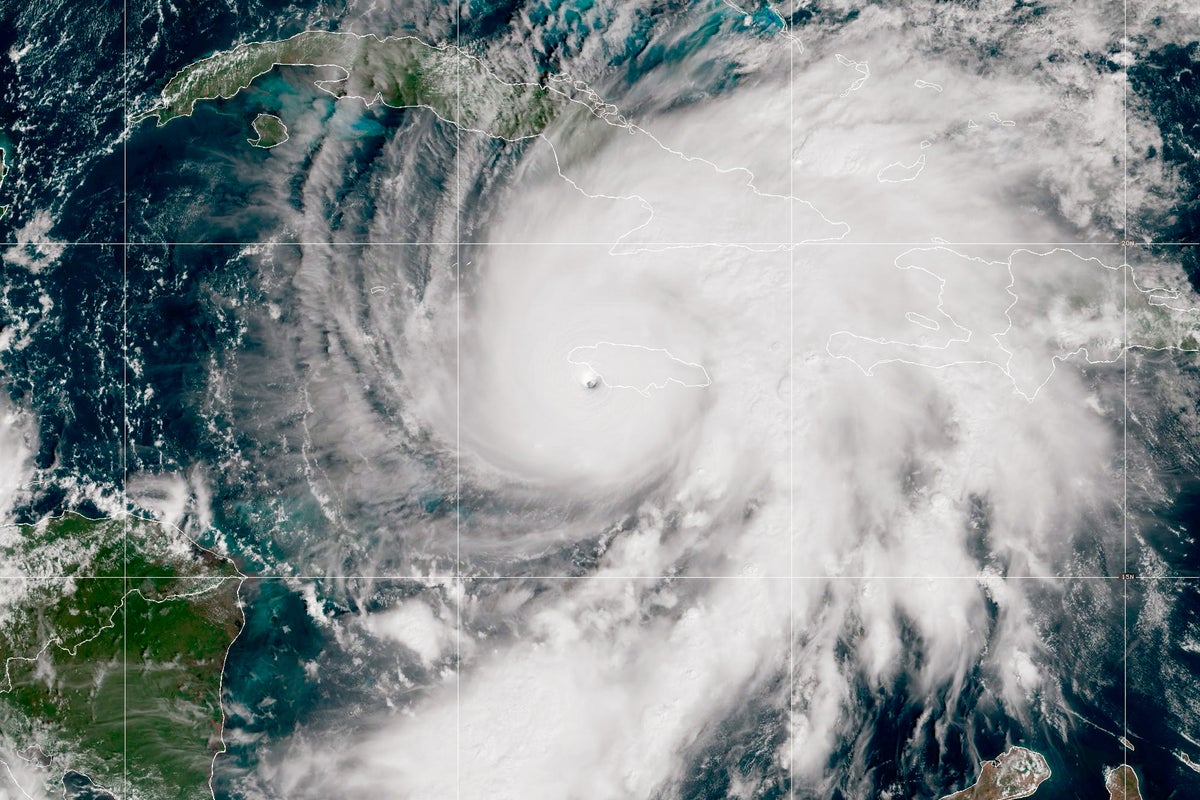
The world’s strongest storm of the year has torn through Jamaica with 185mph winds and flash flooding causing widespread devastation.
Whole towns have been left underwater, one of the island’s airports has been flooded and more than half a million people are without power. Tens of thousands of tourists remain stranded, including 8,000 Britons, with thousands of locals in shelters.
Footage of the damage to the airport in Montego Bay showed seating areas ripped up, broken glass and collapsed ceilings after the Category 5 storm hit. Four hospitals were damaged, at least one with its roof torn off, trees were uprooted and roads were deluged overnight.
Seven people were killed by the storm before it even made landfall on Tuesday, three in Jamaica, three in Haiti and one in Dominican Republic while one person has been reported missing.
The US National Hurricane Centre (NHC) in Miami declared Melissa one of the most powerful hurricane landfalls on record in the Atlantic basin.
Melissa’s winds subsided as the storm drifted past the mountains of Jamaica, lashing highland communities vulnerable to landslides and flooding before moving on to Cuba.
In southwestern Jamaica, the parish of Saint Elizabeth was left “underwater”, an official said. Describing it as Jamaica’s “breadbasket”, government minister Desmond McKenzie said the district had “taken a beating” with extensive damage.
“Our country has been ravaged by Hurricane Melissa but we will rebuild and we will do so even better than before,” Jamaica’s prime minister Andrew Holness said early on Wednesday.
“The reports that we have had so far would include damage to hospitals, significant damage to residential property, housing and commercial property as well, and damage to our road infrastructure.”
Local media reported a disaster coordinator suffered a stroke at the onset of the storm and was rushed to hospital. Late on Tuesday, many areas remained cut off.
The government said it hopes to reopen all of Jamaica’s airports as early as Thursday to ensure quick distribution of emergency relief supplies.
The US government said it was deploying a disaster response team and search and rescue personnel to the region while British prime minister Keir Starmer said the UK had a Royal Navy vessel and specialists in the area ready to provide support. The UK Foreign, Commonwealth and Development Office (FCDO) urged British nationals in Jamaica to register their presence through the government website to receive updates.
Kyle Holmes, who is from Bolton in the UK and visiting Jamaica for a wedding with his wife and three daughters, told the BBC his hotel in the town of Lucea now looks like a “disaster zone”. Mr Holmes said he and his family were now safe after the “worst experience ever” and barricading the windows of the family’s room with furniture.
Rising floodwaters have left the island vulnerable to reptiles as officials in Kingston issued a warning to be beware of crocodiles. The country’s environmental agency said the reptiles may have been swept from their natural habitats by Hurricane Melissa’s torrential rains and could appear in unexpected places, including flooded streets and yards.
Melissa made landfall – where the eye of the storm moves over land – near the town of New Hope, 39 miles south of Montego Bay, packing maximum sustained winds of 185mph, the US National Hurricane Centre said.
The most powerful level on the Saffir-Simpson scale, Category 5, requires speeds of at least 157mph. Moving at a deceptively glacial pace of around 3mph, the tropical storm intensified from Category 4 to Category 5 within 24 hours.
After reducing in intensity to a Category 4 on Wednesday and crossing eastern Cuba, where 500,000 people have been ordered to leave their homes, Melissa is forecast to head through Bermuda and the Bahamas.
The World Meteorological Organisation’s tropical cyclone specialist Anne-Claire Fontan said. “For Jamaica, it will be the storm of the century, for sure.”
Scientists say hurricanes are intensifying faster with greater frequency as a result of warming ocean waters caused by greenhouse gas emissions. Many Caribbean leaders have called on wealthy, heavy-polluting nations to provide reparations in the form of aid or debt relief to tropical island countries.
The NHC put out urgent advice to “put as as many walls as possible you and the outside”. It added: “An interior room without windows, ideally one where you can also avoid falling trees, is the safest place you can be in a building. You can cover yourself with a mattress and wear a helmet for protection.”
Meteorologists at AccuWeather said Melissa ranked as the third most intense hurricane observed in the Caribbean, after Wilma in 2005 and Gilbert in 1988 – the last major storm to make landfall in Jamaica.
Mike Brennan, director of the NHC told the BBC that even after Melissa passed over the island, the “flooding risk, and just the post-storm environment in Jamaica, is going to be extremely dangerous with widespread trees and power lines down, significant structural damage” and that it will remain a dangerous environment, particularly in the west and in the mountains, “for days, if not weeks to come”.
